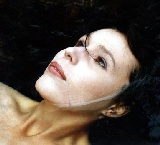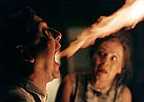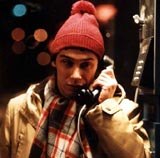Is there a new wave in Czech cinema? "The Velvet Generation," a four-day festival of contemporary Czech film held at London's Riverside Studios, would like us to believe that there is. As well as allowing Londoners the rare opportunity to see many of these films together and also setting them in a wider context, the long weekend was attended by both Saša Gedeon and Alice Nellis.
Important movements in cinema often become apparent after the fact and may not be obvious to the participants.  Yet, the critical and commercial success of films such as Kolja (Kolya, 1996), Knoflíkáři (Buttoners, 1997), Pelíšky (Cosy Dens, 1999), Návrat idiota (Return of the Idiot, 1999), Musíme si pomáhat (Divided We Fall, 2000), Samotáři (Loners, 2000), and Ene bene (Eeny meeny, 2000) suggests that something is afoot.
Yet, the critical and commercial success of films such as Kolja (Kolya, 1996), Knoflíkáři (Buttoners, 1997), Pelíšky (Cosy Dens, 1999), Návrat idiota (Return of the Idiot, 1999), Musíme si pomáhat (Divided We Fall, 2000), Samotáři (Loners, 2000), and Ene bene (Eeny meeny, 2000) suggests that something is afoot.
The fact that anything at all should be happening seems very much against the odds. The Czech New Wave of the 1960s, which produced such international successes as Jiří Menzel's Ostře sledované vlaky (Closely Observed Trains, 1966), Obchod na korze (The Shop on the High Street, 1965) by Ján Kadár and Elmar Klos, and Miloš Forman's Hoří, má panenko (The Firemen's Ball, 1967), to name but three, had depended on the backing of a nationalised industry.
Freed from the worst constraints of ideology (in the late sixties, at any rate) and the cruder demands of the market, Czech cinema had enjoyed a unique degree of creative freedom. British director Lindsay Anderson described the conditions for film-makers as potentially the best in the world.
Things have got to get worse...
All hope that, after 20 years of post-invasion "Normalisation," the industry would again be entrusted into the hands of film-makers came to an end with the progressive denationalisation of the industry in 1990 to 1993. The immediate impact of the "free market" was to lead to reduced audiences, a decline in the number of cinemas, US market domination and a fall in the number of films produced. There are apparently only two European countries that receive no direct government subsidy for film-making: the Czech Republic and Albania.
 This worsening of conditions at a time of hope is no doubt what led to the failure of the older generation of directors to realise their ambitions. Most have, however, remained active. Some, such as Karel Kachyňa, have made sensitive low budget films (Kráva / The Cow, 1994 and Hanele, 1999). Others, such as Jan Schmidt and Drahomíra Vihanová, made perceptive but largely ignored films about the Communist period (Vracenky / Returns, 1990 and Pevnost/The Fortress, 1994 respectively).
This worsening of conditions at a time of hope is no doubt what led to the failure of the older generation of directors to realise their ambitions. Most have, however, remained active. Some, such as Karel Kachyňa, have made sensitive low budget films (Kráva / The Cow, 1994 and Hanele, 1999). Others, such as Jan Schmidt and Drahomíra Vihanová, made perceptive but largely ignored films about the Communist period (Vracenky / Returns, 1990 and Pevnost/The Fortress, 1994 respectively).
Věra Chytilová has managed to reach and challenge audiences with her "anti-capitalist" comedy Dědictví (Inheritance, 1992) and the black comedy Pasti, pasti, pastičky (Traps, 1998), which uses rape as its basis for an analysis of power and morality. However, Jiří Menzel, after the surprise box office failure of his Život a neobyčejná dobrodružství vojáka Ivana Čonkina (The Life and Extraordinary Adventures of Private Ivan Chonkin, 1994) and much publicised legal problems with his attempts to set up an adaptation of Bohumil Hrabal's novel, Obsluhoval jsem anglického krále (I Served the King of England), seems to have retreated definitively to theatre.
None of them has managed to repeat the creative or commercial success that characterised their earlier work. Jan Švankmajer continues, of course, and has recently completed Otesánek (2000) but, one suspects, only because of a unique international interest and support.
...before they get better
It is against this not too promising background that Czech cinema has refused to lie down. The early years, of course, saw the emergence of Jan Svěrák with his Oscar-nominated Obecná škola (The Elementary School, 1991), one of the last products of the nationalised industry, to be followed in quick succession by his science fiction parody Akumulator I (1994), the low budget Jízda (The Ride, 1994) and culminating with the Oscar award for Kolja.
Svěrák seemed an exception, but then, although less noticed  internationally, came the feature debuts of Saša Gedeon (Indiánské léto / Indian Summer, 1994), which won several international awards, and Jan Hřebejk (Šakalí léta / The Jackal Years aka Big Beat, 1993), which was one of the two top box office films of 1994. The first presented a low-key Formanesque but visually sophisticated account of two young female cousins and a summer spent at their grandmother's country house. Šakalí léta was a spirited rock musical set in the 1950s.
internationally, came the feature debuts of Saša Gedeon (Indiánské léto / Indian Summer, 1994), which won several international awards, and Jan Hřebejk (Šakalí léta / The Jackal Years aka Big Beat, 1993), which was one of the two top box office films of 1994. The first presented a low-key Formanesque but visually sophisticated account of two young female cousins and a summer spent at their grandmother's country house. Šakalí léta was a spirited rock musical set in the 1950s.
With their second films, Návrat idiota (Gedeon) and Pelíšky (Hřebejk), each made after a gap of five years, they have confirmed their early promise. Gedeon's sensitive account of a young man's involvement in the emotional relationships of a small provincial town not only evokes the microworld once examined by directors such as Miloš Forman and Ivan Passer but presents it in an elegiac visual style that is both subtle and precise.
 Continuing his partnership with screenwriter Petr Jarchovský, Hřebejk's Pelíšky, based on motifs from Petr Šabach's book Hovno hoří (Shit Burns), weaves a complex web of family relations, a kind of collective memory of the year 1968.
Continuing his partnership with screenwriter Petr Jarchovský, Hřebejk's Pelíšky, based on motifs from Petr Šabach's book Hovno hoří (Shit Burns), weaves a complex web of family relations, a kind of collective memory of the year 1968.
Perhaps most impressive here is the way in which Jarchovský reinvigorates conventional narrative together with Hřebejk's control of some dominant acting talents. The phenomenal response to Pelíšky in the Czech Republic has propelled Hřebejk and Jarchovský to further success with their Oscar-nominated drama of the Germann occupation, Musíme si pomáhat. They have now inherited Menzel's doomed project, Obsluhoval jsem anglického krále.
Less is more
More recently, we have seen the debuts of Petr Zelenka (Mňága-Happy  End, 1996, Knoflíkáři and the screenplay for David Ondříček's Samotáři), Roman Vávra (Co chytneš v žitě / In the Rye, 1998) and Alice Nellis (Ene bene), all made on shoestring budgets. As Alice Nellis said at this year's London Film Festival, the new directors have to concentrate on ideas and subtleties, because they don't have the money to blow up cars.
End, 1996, Knoflíkáři and the screenplay for David Ondříček's Samotáři), Roman Vávra (Co chytneš v žitě / In the Rye, 1998) and Alice Nellis (Ene bene), all made on shoestring budgets. As Alice Nellis said at this year's London Film Festival, the new directors have to concentrate on ideas and subtleties, because they don't have the money to blow up cars.
Restrictions, Krzyzstof Kieślowski once remarked, often give rise to ingenuity and innovation. Perhaps this also accounts for the importance of the script, and it is notable that both Zelenka and Nellis (like Forman before them) were students of screenwriting when they were at FAMU (the Prague Film School). Hřebejk also studied screenwriting, and Gedeon had contributed to literary magazines before enrolling at FAMU.
Alongside the work of Gedeon, Hřebejk, Nellis, Zelenka, Ondříček and Vávra were films by cinematographer and documentary director Ivan Vojnár  (Cesta pustým lesem / The Way Through the Bleak Woods, 1997) and cinematographer Jaroslav Brabec (Kuře melancholik / The Melancholic Chicken, 1999). Like Štěpán Kučera's work for Gedeon, these two works reflect the strong visual tradition of Czech film that dates back to Gustav Machatý's Erotikon (1929) and Extase (Ecstasy, 1932). And surely it's time that the unfashionably titled Cesta pustým lesem was more widely recognised for a visual perception and sensitivity all too rare in contemporary cinema.
(Cesta pustým lesem / The Way Through the Bleak Woods, 1997) and cinematographer Jaroslav Brabec (Kuře melancholik / The Melancholic Chicken, 1999). Like Štěpán Kučera's work for Gedeon, these two works reflect the strong visual tradition of Czech film that dates back to Gustav Machatý's Erotikon (1929) and Extase (Ecstasy, 1932). And surely it's time that the unfashionably titled Cesta pustým lesem was more widely recognised for a visual perception and sensitivity all too rare in contemporary cinema.
The mechanics of survival
But how does such a cinema continue to exist and develop when, despite the unquestionable domestic success of many of the films, the logic of the global market would seem to suggest otherwise? "It's a miracle," says Vávra, "that names like Svěrák and Gedeon could grow from a situation like this." One factor is undoubtedly the existence of what can be called a film culture—the Film School continues to produce graduates who want to make films, the Národní filmový archiv (National Film Archive) continues to foster awareness of a film tradition.
Another factor is support from television and, specifically, public service television. Česká televize (Czech Television) usually has a 40 to 50 percent investment in the films produced and provides continuity of employment via television drama and often impressive documentaries. Many film-makers, of course, work in music videos and advertising. According to David Ondříček, speaking in an interview for Central Europe Review, private investors can normally expect to regain 80 percent of their investment.
The Riverside programme revealed the continuing importance of the film school, through showing not only the early FAMU documentaries of Gedeon and




